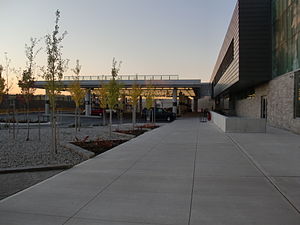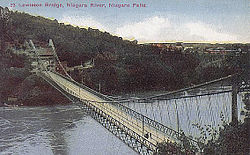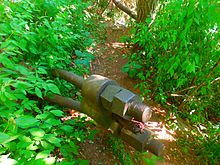Lewiston–Queenston Bridge
Lewiston–Queenston Bridge | |
|---|---|
 The bridge as seen from Niagara Gorge. | |
| Coordinates | 43°9′11″N 79°2′40.03″W / 43.15306°N 79.0444528°W |
| Carries | 5 reversible lanes of |
| Crosses | Niagara River |
| Locale | Queenston, Ontario and Lewiston, New York |
| Maintained by | Niagara Falls Bridge Commission |
| Characteristics | |
| Design | Arch |
| Total length | 1,594 feet (486 m) |
| Width | 24 feet (7 m) |
| Longest span | 1,000 feet (305 m)[1] |
| Clearance below | 370 feet (113 m)[1] |
| History | |
| Engineering design by | Hardesty & Hanover[2] |
| Fabrication by | Bethlehem Steel[2] |
| Construction cost | $16 million [3] |
| Opened | November 1, 1962 |
| Statistics | |
| Daily traffic | 10,406 AADT |
| Toll | Canada-bound only: $5.00 USD or $6.50 CAD per passenger vehicle[4] |
| Lewiston–Queenston Border Crossing | |
 Canada Border Inspection Station at the Lewiston–Queenston Bridge | |
| Location | |
| Country | United States; Canada |
| Location |
|
| Details | |
| Opened | 1962 |
| US Phone | (716) 282-1500 |
| Canadian Phone | (905) 262-4010 |
| Hours | Open 24 hours |
| Website http://www.cbp.gov/contact/ports/buffalo | |
| Location | |
 | |
The Lewiston–Queenston Bridge, also known as the Queenston–Lewiston Bridge, is an arch bridge that crosses the Niagara River gorge just south of the Niagara Escarpment. The bridge was officially opened on November 1, 1962. It is an international bridge between the United States and Canada. It connects Interstate 190 in the town of Lewiston, New York to Highway 405 in the community of Queenston, Ontario. The Lewiston–Queenston Bridge is architecturally similar to the Rainbow Bridge at nearby Niagara Falls.
Customs plazas are located on both ends of the bridge, with tolls only being charged on entering Canada ($5.00 USD or $6.50 CAD per passenger automobile). The bridge accepts E-ZPass electronic toll collection and houses the second Canadian E-ZPass collection facility, after the nearby Peace Bridge. Also, two duty-free stores are located between the two plazas.
The bridge permits no pedestrians, but licensed taxi service is permitted.[5] The Lewiston–Queenston Bridge lacks expedited border clearance facilities for NEXUS and FAST card holders traveling from the United States into Canada, but does have a NEXUS lane for travel into the United States.
Gantries have lights indicating the direction of traffic as the lanes are reversible. Speed limit is posted in kilometres and miles per hour (15 mph or 24 km/h limit) along the bridge. Canadian and United States flags fly at the midpoint on the south side of the bridge.
Border crossing and toll
[edit]The crossing is the fourth-busiest on the Canada–United States border, with delays of up to two hours.[citation needed] It is on the most direct route connecting the US Interstate system to Toronto and Detroit.[6] Canada replaced its border inspection facilities in 2011. The United States announced plans in 2016 to spend US$50 million to upgrade the primary inspection facilities.[7] Construction was completed in 2022. Both facilities are open 24 hours per day, 365 days per year. All commercial vehicles crossing between the US and Canada at the Niagara River must use this crossing.
The toll for use of the bridge is payable upon entering Canada only.
- Canada-bound:
- 10 customs booths for cars/RVs
- 5 customs booths for trucks
- Dedicated Bus Processing Lane
- parking area for trucks for inspections
- helipad
- 6 toll booths
- US-bound:
- 6 customs booths for cars/buses/RVs
- 3 customs booths for trucks
- parking area for trucks for inspections
Passenger vehicles pay a toll only when entering Canada from the US. The cost is $5.00 USD or $6.50 CAD, as of August 1, 2022, payable by cash or E-ZPass.
High mast lighting is used on the Canadian side, with regular light standards used for bridge and the US side.
Previous suspension bridges
[edit]
The first Queenston-Lewiston Bridge was built in 1851 by engineer Edward Serrell and wrecked by wind in 1864 (or 1854[8]). Newspapers reported that bridge deck had been destroyed in February 1864 by wind which caused main deck to sway excessively due to earlier removal of stabilizing guy-wires by local authorities, however main suspension cables remained fully intact.[9] Some of the cables were still in place as late as 1895.[10] The road deck span was about 841–849 ft (256–259 m). The suspension bridge design was unusual because the cables were attached to the cliff with only small towers. This made the road deck span shorter than the cable span of 1,040 feet (317 m).
A second bridge called the Queenston-Lewiston Bridge, a suspension bridge was later constructed. Located seven-tenths mile (1.1 km) north of the current bridge, this suspension bridge was originally built near the present location of the Rainbow Bridge, and was moved to Queenston in 1898 by R.S. Buck and engineer L.L. Buck, after the completion of the Rainbow Bridge's predecessor, the Upper Steel Arch Bridge. The suspension bridge was dismantled in 1963 after the current bridge was completed and opened.

Reminders of the earlier bridge are still visible in the area. First is two columns that lie within the Earl W. Brydges Artpark State Park. Second is the original plaque, now located midspan alongside the road, right at the border between the two countries. The plaque is flanked by a US and a Canadian flag.
The supports are part of Owen Morrell's Omega, a steel sculpture and observation platform added in 1981.[11] Two columns remain on the Canadian side at the foot of York Street in a wooded area now known as York Park.
Plane crash
[edit]On December 1, 1961, while the bridge was under construction, an F-100 fighter (variously reported as belonging to the United States Air Force[12] or Air National Guard[13]) caught fire just after taking off from a base near Niagara Falls, New York. To protect people in the city, the pilot steered it into the Niagara River gorge before safely ejecting; but this aimed it near the construction site.[12][13] It passed not far over the heads of workers near the site, missed a construction crane by about 100 feet (30 m), and crashed into the gorge side about 600 feet beyond the bridge before falling into the river.[12]
See also
[edit]- List of bridges documented by the Historic American Engineering Record in New York
- List of bridges in Canada
- List of bridges in the United States by height
- List of Canada–United States border crossings
- List of crossings of the Niagara River
 Engineering portal
Engineering portal New York (state) portal
New York (state) portal Ontario portal
Ontario portal Transport portal
Transport portal
References
[edit]- ^ a b "Lewiston-Queenston Bridge". HighestBridges.com. December 10, 2009. Archived from the original on May 21, 2016. Retrieved November 1, 2016.
- ^ a b American Institute of Steel Construction, Prize Bridges 1962 (PDF), archived from the original (PDF) on August 31, 2021, retrieved January 12, 2024
- ^ "Bridges Over Niagara Falls". Niagarafrontier.com. Retrieved February 27, 2016.
- ^ "Toll Cost & Vehicle Definitions". Retrieved August 1, 2022.
- ^ "Which Bridge Do I Take?". Niagara Bridge Commission. Retrieved July 5, 2019.
- ^ "Chapter 4: The Watery Boundary". United Divide: A Linear Portrait of the USA/Canada Border. The Center for Land Use Interpretation. Winter 2015.
- ^ Anderson, Dale; McCarthy, Robert (February 19, 2016). "U.S. side of Lewiston-Queenston Bridge to get $50 million upgrade". The Buffalo News. Retrieved February 22, 2016.
- ^ "Bridges over Niagara Falls". Thunder Alley. May 2, 2019. Retrieved July 5, 2019.
- ^ Buffalo Courier 2-5-1864, page 3
- ^ "1851 Lewiston-Queenston". Bridgemeister. Retrieved July 5, 2019.
- ^ "Work: Omega". Owen Morrel Studios. Retrieved July 5, 2019.
- ^ a b c "Pilot Guides Blazing Jet Into Gorge". The Globe and Mail. Toronto. December 2, 1961. p. 1.
- ^ a b "Jet Ablaze: Pilot Stays to Save City". Toronto Daily Star. December 2, 1961. p. 52.
External links
[edit]- Lewiston-Queenston Bridge (1962) at Structurae
- Niagara Falls Bridge Commission
- Images from the Niagara Historic Digital Collections
- Live Traffic Camera of Lewiston Queenston Bridge
- Lewiston Queenston Bridge Collection of Images Niagara Falls Public Library (Ont.)
- Historic American Engineering Record (HAER) No. NY-552, "Lewiston-Queenston Bridge, Spanning Niagara River, Lewiston, Niagara County, NY", 1 photo, 1 photo caption page
- 1962 establishments in New York (state)
- 1962 establishments in Ontario
- Buildings and structures in Niagara-on-the-Lake
- Bridges completed in 1962
- Bridges in Niagara County, New York
- Bridges on the Interstate Highway System
- Bridges over the Niagara River
- Canada–United States border crossings
- Canada–United States bridges
- Historic American Engineering Record in New York (state)
- Interstate 90
- Open-spandrel deck arch bridges in Canada
- Open-spandrel deck arch bridges in the United States
- Road bridges in New York (state)
- Road bridges in Ontario
- Roads with a reversible lane
- Steel bridges in Canada
- Steel bridges in the United States
- Toll bridges in Canada
- Toll bridges in New York (state)
- Tolled sections of Interstate Highways
- Transport in the Regional Municipality of Niagara
